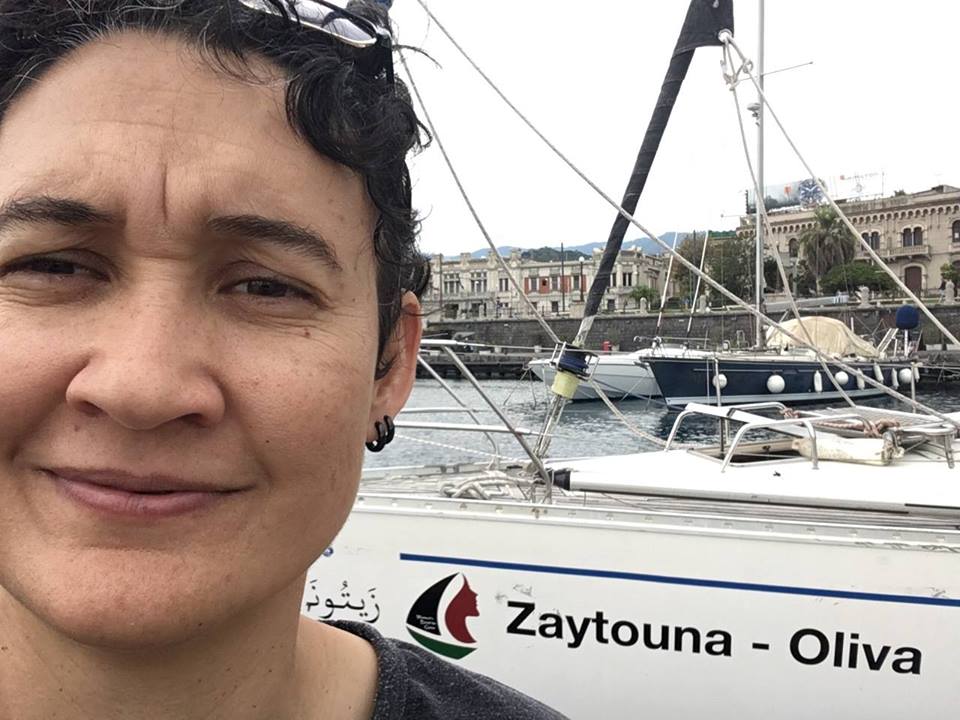On Friday, an emotional Leigh-Ann Naidoo returned home to a crowd of pro-Palestinian supporters after being captured in international waters while on board the Women’s Boat to Gaza. Naidoo, a wits academic and activist, along with 12 other women from around the world, was enroute to attempt to break the blockade imposed on the besieged territory by Israel. The women were captured approximately 35 nautical miles from the shores of the Gaza Strip and rerouted to the shores of Ashdod where they were transferred to the Givón prison.
The Freedom Flotilla Coalition launched two boats, the Zaytouna and the Amal from the shores of Barcelona in September, 2016. While the Zaytouna successfully embarked on the planned journey, the second boat, Amal, early in its journey experienced engine problems, forcing the crew and activist to return to port.
The organizers of the flotilla chose participants from around the world, including politicians, members of the media, cultural artists and activists. They include: Nobel Laureate (1976) and peace activist from Northern Ireland, Mairead Maguire; member of New Zealand Parliament and member of the Green Party, Marama Davidson; professional athlete and coach, whose husband was killed on the Mavi Marmara in 2010, Cigdem Topçuoglu, and Wits academic, Leigh-Ann Naidoo.
Speaking to VOC’s Breakfast Beat Show, Naidoo explains that the crew and activists were expecting to be intercepted within 100 nautical miles of the coast of the Gaza Strip, a distance that takes approximately 20 hours to travel.
While those on board were hopeful that they would not be intercepted, she says that they began monitoring the horizon as they ebbed closer to the shore.
“Obviously people were getting nervous, but we became confident and counted down the miles and then we started thinking maybe we will actually make it,” Naidoo recalls.
Naidoo says that after discovering that their satellite feed was disconnected within approximately 40 nautical miles of the coast, they knew that their interception was imminent.
She explains that following the disruption in signal, three “big war ships” appeared on the horizon and the Israeli military began radioing the Zaytouna to stop.
“There was a whole negotiation between our captain and the military, which took about an hour. They were basically trying to convince us that we must come with them to the Ashdod port and we can drive our boat. If not, they can come on board and drive our boat or we can get on their faster boat – they gave us all kinds of options,” she added.
The crew affirmed to the military personnel that the flotilla is on a peaceful mission to break the illegal blockade and that they intend to complete their mission.
“There was a moment when the person on the other side of the radio said that we are clearly not cooperating and that they need to use force to stop us from entering Gaza.”
Given the level of violence inflicted on the Mavi Marmara in 2010, Naidoo asserts that those on board became concerned about the threats made by the Israeli military.
She confirmed that following the threats made by the military personnel, the Zaytouna was subsequently flanked by zodiac boats, which were fully equipped with military paraphernalia.
“We had decided that we would be peaceful once they had boarded and that we had a boat that would not out run them. We then agreed that we would not engage them; our resistance was now going to be to not sign anything,” she said.
Naidoo notes that she was unable to keep to the decision when the Israel forces confiscated any technology, such as phones and recording equipment, which may have been recording the capture.
She says the confiscation of the technology was an attempt by the Israeli forces to control the narrative of what transpired.
“Next to u, on the zodiac, there was a camera man recording and every officer, about eight of them, had GoPros on them. So, they were recording everything that was happening – but of course they control what was put out.”
Naidoo says that part of controlling the narrative, was the fact that Israeli forces had placed water and Israeli food at the disposal of the crew and activists.
“Some of our crew who were hungry ate of it and at that moment I said I do not eat Israeli products at home, I support BDS and I am not about to eat your food here. At that moment it became clear that the cameras were trying to capture a moment where it looked like it was a very peaceful engagement,” she noted.
Having spent several hours on the vessel with the Israeli soldiers, Naidoo asserts that it was interesting to note that the soldiers were “very young.”
She said that in spite of the armoury and uniforms, the soldiers appeared quite afraid and bewildered by the capture.
Speaking about her ability to control herself in the face of such force, Naidoo explains that she found the strength to compose herself by remembering that worse atrocities is being imposed on Palestinians.
“We had high profile people on board and media coverage, so it was clear that if something happened to us it would be terrible for the Israeli state. But we need something to propel this resistance to act differently – even if something was to happen, we hoped it would contribute to change,” she continued.
VOC News 91.3fm






 WhatsApp us
WhatsApp us 

